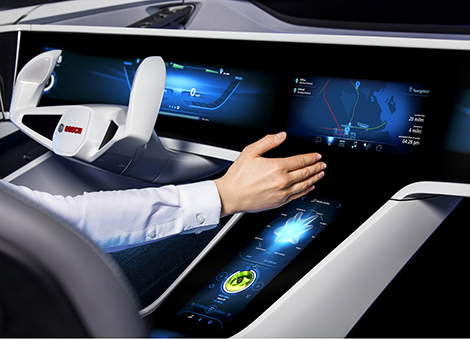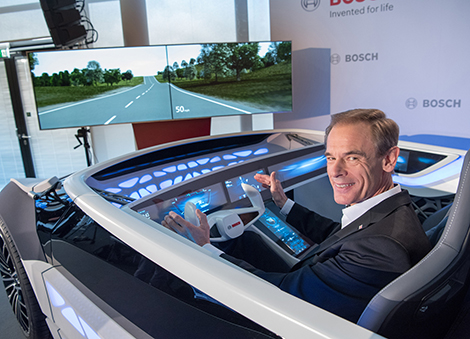
The interior of Bosch’s concept of the future showcases how IoT connectivity is set to transport car interior design
According to global products giant Bosch, the global market for connected mobility is set to grow by almost 25 per cent each year before 2022, transforming cars into mankind’s ‘third living space’ alongside home and work.
In just a few years, cars will become an active part of IoT, and will be able to communicate with other modes of transportation as well as with the smart home.
Bosch unveiled its Forward ShowCar at Mobile World Congress in Barcelona, with the simulator showcasing a broad range of technologies, including a face recognition Driver Monitoring Camera, setting the steering wheel, mirrors, interior temperature, and radio station according to that particular driver’s personal preferences.

Bosch’s CEO, Dr. Volkmar Denner, takes the concept for a ride
“The car as we know it will soon be history,” said Dr. Volkmar Denner, CEO, Bosch. “Today you use the internet to book a hotel room; in the future you’ll arrange your mobility online as well.”
To do so, Denner expects that private vehicles will be part of an integrated solution that includes public transportation and even entire urban infrastructures.
“In a few years, mobility will be seamlessly connected,” Denner said. People today still think in terms of their own individual vehicles, but the next few years will see their focus shift toward the most convenient way to reach their destination.”
The latest concept car from Bosch also includes the first ever gesture control with haptic feedback using ultrasound sensors that can sense whether the driver’s hand is in the correct place.
Thanks to the touchscreen with haptic feedback, the buttons that appear on the touchscreen feel like real buttons. This allows drivers to keep their eyes on the road, improving safety.
A camera-based solution replaces both exterior mirrors, with video sensors able to be integrated into the vehicle interior, and images are shown on displays close to the A-pillars on the right and left sides of the car.
The concept is part of Bosch’s future vision of how different spheres of life will be seamlessly interconnected in the future beyond the vehicle itself.
More applications are being geared around the mobile phone – hence the launch at MWC – to make life ‘easier and more personalised’ for users.
Perfectly Keyless is a user-centric vehicle access system that offers the driver full passive entry and passive start functionality using the smartphone as a digital car key.
With the encrypted digital key on the phone, the vehicle can be unlocked and started without any interaction.
When approaching the vehicle, the system will automatically identify the secret key on the smartphone and perform a distance measurement: within a specified range to the car (approximately two metres), access is allowed. The car can also only be started if Perfectly Keyless locates the mobile device inside the car.
Bosch also on the growing demand for smart connectivity solutions for motorcycles, with an Integrated Connectivity Cluster rider information system, developed specifically for motorcycles.
It features variable display sizes and resolutions and, thanks to the latest technology, making it easier to read in all situations.
An integrated eScooter system from Bosch also showed the improved interaction between single components as connected system solution. It provides easy access to the most relevant and reliable information via HMI and/or smartphone app: e.g., battery status, speed, remaining mileage, and failure and diagnosis information.
The ‘take me home’ function can calculate the optimal route, and the ‘anti-theft’ function alerts the eScooter owner via smartphone if the scooter is being moved without authorisation. Sharing as well as fleet management functionality is part of the integrated system too.
Not everything is automotive related, with Bosch also presenting its optical Microelectromechanical Systems (MEMS) solution, with uses for various IoT solutions.
Tiny Bosch MEMS sensors can be found in most electronic devices, from smartphones, gaming consoles and tablets, to vehicle applications and safety systems and countless other devices, acting as the eyes and ears of millions of electronic devices.






